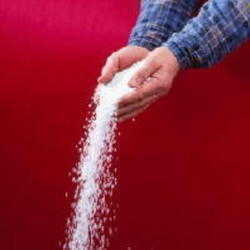Calcium is an alkaline material widely distributed in the earth. It is the fifth most abundant element (by mass), usually found in sedimentary rocks in the mineral forms of calcite, dolomite and gypsum.[1] We often see it as marble or limestone, which is formed by calcium carbonate rock dissolved in water containing carbon dioxide. Stalactites are formed by a slowly dripping solution of calcium carbonate mixed with other minerals. The same calcium carbonate dissolved in water is what makes our drinking water “hard.”
Calcium is found in as many as 80 compounds sometimes called calcium salts such as calcium carbonate (lime), calcium phosphate (fertilizers), calcium sulfate (Plaster of Paris), calcium gluconate (vitamins), calcium chloride (ice removal), and others.[2} In some compounds the calcium is soluble, but in most calcium compounds found in soils, the calcium is generally insoluble. 'Insoluble' here means the calcium is not readily available to plants. Calcium in the soil, because it is relatively insoluble, tends to not leach away either, thus keeping the soil pH more alkaline if there is an abundance of calcium.
 |  |  |
| Calcium Deposits | Marble | Stalactites |
All animals and humans need calcium, but we don’t go around eating limestone or stalactites. Humans eat plants and animals, which are a calcium source, but the plants and animals have to get it from somewhere. Animals and humans do eat plants as a calcium source, but the plants need calcium first. So, how DO plants get calcium if it is basically insoluble in the soil? The answer is that soil microbes need calcium too, so they eat calcium compounds, converting them into a form plants can use. The trick is to determine which calcium compounds are needed by the microbes for the easiest and best conversion. Which calcium compounds are best to do the job and yet not increase the pH too much? (Remember, calcium is alkaline.) Most importantly, why do plants even need calcium since they have no bones nor teeth?
 |  |
| Wall structure in plant stem | Chloroplast cells |
Plants need calcium for cell wall development and growth. Pathogens attack weak cell walls to invade a plant, and stronger cell wall structure avoids this. Plants need calcium for enzyme activity, metabolism, and for nitrate (a useable form of nitrogen) uptake. Calcium and phosphorus are often found together. Plants need phosphorus to grow strong and healthy, for moisture regulation, photosynthesis, respiration, and metabolism. Weak and spindly plants often indicate the plants are not taking up enough phosphorus and calcium. Of course, there are other factors affecting plant growth such as pH imbalance, high sodium, over- and under-watering, poor drainage (humus can help with this), lack of oxygen (from compaction, and lack of organic material), and temperature stress. The ratio of calcium to magnesium is said to be a factor, but I have seen no research indicating such when considering the calcium form necessary for best plant uptake. Too much sodium in the soil can also bind up calcium and make it unavailable to plants.
Soil tests will tell you if you have the correct pH and if the soil is too acidic, a recommendation to apply lime will be included. Generally, a lime application such as “high calcium” lime, dolomitic lime, and gypsum (calcium sulfate) will contain calcium in forms not readily available for plants’ immediate use. My recent soil test showed very high levels of calcium, and the pH is also a little higher than I prefer. However, I know from watching my plant growth that most of the calcium in my soil is not available to my plants. My solution after lots of research, is to apply a soft rock phosphate which is colloidal phosphate: a highly soluble natural source of phosphate and calcium. Soft Rock Phosphate will aid greatly in raising Brix in your garden. (I use CalPhos but there are others available.) Soft rock phosphate is not the same as rock phosphate, Tennessee Brown Rock phosphate, or hard rock phosphate. All those do contain calcium and phosphorus, but in soft rock phosphate the calcium and phosphorus are in a colloidal form and thus readily available.
Soft rock phosphates are only mined in a few parts of this country, notably Florida where they were laid down eons ago by bony marine animals. Soft rock phosphate also comes from the process of washing rock phosphates of the colloidal compound on the phosphate surface when they are mined. I heard there is a recent calcium find in the Nevada desert thought to be a superior form of calcium, made from marine plant life, but it is not widely available. It is marketed as Kelzyme.
Calcium is essential for all plants, but the following are especially responsive: apples, broccoli, brussels sprouts, cabbage, carrots, cauliflower, celery, cherries, citrus, conifers, cotton, curcurbits, melons, grapes, legumes, lettuce, peaches, peanuts, pears, peppers, potatoes, tobacco, and tomatoes.[3]
“Calcium perhaps plays more roles in the overall health of both the plant and the soil than any other nutrient. As Dr. Albrecht [4] explains it in his volumes of research, if we get the calcium right in the soil, most of our work is done.”[5]
 |
| Calcium for good plants! |
Articles for related information:
The Importance of Microbes in Soil
Footnotes:
[1] http://en.wikipedia.org/wiki/Calcium
[2] http://en.wikipedia.org/wiki/Calcium_salt
[3] http://www.spectrumanalytic.com/support/library/ff/Ca_Basics.htm
[4] Dr. William Albrecht: former head of the soils department at the University of Missouri
[5] Simmons, Joel, http://www.soilfirst.com/tnm_12_1997.htm
Photo Credits:
Milk bottle & glass: # 5842153, iStockPhoto.com, Used by Permission.
Stalactite, # 4358278, © Glenn Frank, iStockPhoto.com, Used by Permission
Stem cross section, # 2937019, © Oliver Sun Kim, iStockPhoto.com, Used by Permission
Chloroplasts, # 6143246, © Nancy Nehring, iStockPhoto.com, Used by Permission
Daisy & Milk, # 6632587, © Monika Gniot, iStockPhoto.com, Used by Permission
Pamukkale, Turkey, Calcium Deposits, # 2216673, © Maxime VIGE, iStockPhoto.com, Used by Permission
Marble: Public Domain
















